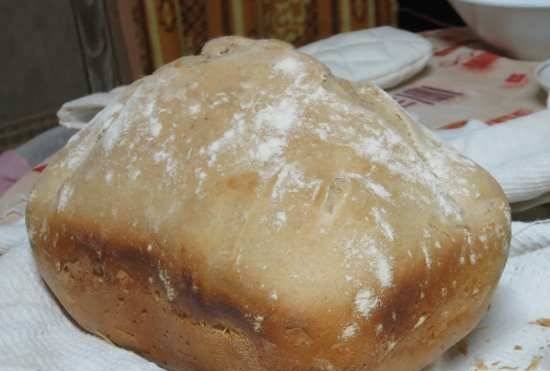Simple sourdough light gray bread in the Bork-X800 bread maker
Category: Sourdough bread

Ingredients |
| Leaven | 130g (including 78 g of water) |
| Opara | 530g |
| Water | 200 g |
| Flour 1 grade | 200 g |
| Dough | 980g |
| Opara | 530g |
| Flour | 350 g |
| Water | 100 g |
| Salt | 1 tsp |
| Sugar | 1 tbsp. l. |
Cooking method
- Below will be what is called in the harsh men's forums "a lot of letters, did not master", "snot", "the author of the type burns, but nothing came of it", etc. So for those who wish (or rather, those who do not want to read a lot), essentially at the bottom of the message.
- I want to share my impressions and ask a bunch of questions after the first attempts to create a yeast-free, easy for health, wallet and time of daily daily bread in a brand new bread maker. Let's start with the result. The first pancake (or rather bread) is not lumpy, although it could have been better.
- Now the background. As an automation specialist (kick further and use foul language - I will understand everything, I will accept ...), I like to keep the processes under control. At least when maintaining the temperature regime for growing sourdough, this approach is not even superfluous, if you take, for example, this: San Francisco Sourdough in 2 days from Mariana-aga. (the test of this leaven is only tomorrow ...). Therefore, starting to choose a model of a bread machine from all that splendor that glitters on the shelves, I was wildly disappointed that everything was tailored to the "teapot" willing to stuff itself with yeast dough. A wild contradiction arises, because the decision to buy a bread machine comes first of all to people who think, who care about their health, the health of their relatives, in a word, not that "People" who simply "hawala", but they are offered devices without alternatives, the control of which is simplified to the degree of an electric kettle! The only way to somehow influence cooking in 99% of models is to replace all shaitan electronics with such ancient and proven procedures as dances with tambourines and other tricks: separately turn on dough kneading, start an alarm, knead again, alarm clock again, ... ., bakery products. And if you get confused by the temperature of proofing or preheating, then these simple operations will also add fuss with the heating battery and blanket, it is almost impossible to influence the baking temperature (if you just stand nearby and turn the bread maker on and off every few minutes).
- BUT! On this wonderful site there is a description of a miracle called Bork-X800, which was successfully one of the first caught the eye on those very counters! Here, the whole simple sequence of a bucket with a heating element and a stirrer is under control, namely:
- Preheating temperature and time
- Mixing time at slow speed
- Mixing time at high speed (8 minutes before the end of which the addition of nuts and fruits is triggered)
- The time of each of the three lifts and the separating two workouts
- The temperature is common for all climbs,
- Time and temperature of baking.
- All periods are set within wide limits (starting from 0, that is, skipping a stage) with a step of 1 minute (kneading - 1 sec), temperature values - 1 degree.
- That is, through trial and error, you can endure your recipes and save them in memory (up to 9 pieces). Then he came home from work, threw in the ingredients, pressed start, mixed flour and water into a leavened jar, pulled out bread before going to bed or in the morning, wrapped it in a rag. The only drawback: there is no pause between two mixes, and they are recommended in many recipes (as "rest" or autolysis from 10 to 60 minutes).To compensate for this, you still need to touch the tambourine a little: first start a program in which only the first batch is 3-8 minutes, then start up another one, starting with preheating, the time and temperature of which will thus “let the dough lie down”.
- Now the story itself. 130g of sourdough of consistency "according to Calvel", that is, with a water: flour content 60: 100 mixed (by a loving mother) into the dough by adding 200g of flour and 200g of water. After 6 hours, no matter how the mother bowed to the ground (so that the son would come, but the box would not), a son appeared on the threshold with a spark in his eyes and a box (as always “the cheapest”). With a sigh, the mother let this cup into the kitchen, into which the dough was then placed (it remained on the walls of the jar for wiring), about 70g of 2nd grade flour, 30g of rye, 250g of 1st grade (Kazakhstan), 100g of water. 1 tsp salt and 1 tbsp. l. Sugar, according to the son's blind and unfounded faith in technical progress, was poured into the dispenser, which turned out to be despicable "in the hole", that is, ONLY for nuts / fruits / berries. That is, 10 percent of the sugar-salt was in the dough right away. Then the wildest thing began - programming the bakery. The recipe Basic (basic) was chosen as the basis, in which the time of the first batch was changed from 3 to 8 minutes, 2 batches from 22 to 32 minutes, the kneading was reset to 0 minutes, the total rise time was 3 hours, the rise temperature was reduced from 32 to 29 degrees, the time baking was left by default for 60 minutes, the baking temperature was reduced from 140 to 138 degrees. After pressing start, theory and practice began their friendly rapprochement, notoriously ending with the one that, in common parlance, "comes out lumpy." To the delight of the natural scientist, HP does not prevent in any way from looking under the cover. The first 20 minutes of kneading, everything went "according to plan", then the nightmare began: the dough, which had already almost completely cleaned the container after itself, suddenly began to "unstick", "splatter" back, stick terribly to hands when touched. In general, everything was urgently canceled with the Cancel button. Not long before that, an article was read about the influence of kneading-mixing processes on the structure of the dough in the excellent LJ Mariana-aga Development of gluten by kneading and in other ways, the essence of which is that in the process of kneading the gluten of the dough first grows, then upon reaching the maximum, the dough begins to fall turns into glue, and the number of revolutions to which the desired maximum will fall naturally elusively plays on the "strength" of flour, the composition of the dough, etc. At this point I ask not tired (I hope there are still some!) to read this opus for respected ladies and masters of bread makers a burning question: is it really true that in 20-25 minutes (maybe all 30 - in a fever I did not fix it) this "mix" can come for the mixture of flour that I laid, or is it a normal stage, after which everything is back to normal? But at that time there was no one to ask, with the help of fingers and a wooden spatula, everything was collected in something like this:
- Then 3 minutes were set for the first and 5 minutes for the second kneading, the remnants of salt and sugar in the dough were picked out of the ill-fated dispenser (some fell past the mold). The kneading went unexpectedly well - the dough was not very smeared in shape (by the way, I did not grease it with anything), but then it still stuck to my hands - I had to moisten them with water. The dough turned out to be a kolobok, awkwardly and asymmetrically located in the form, with wet hands it was distributed over the entire area, shaded with a cross and closed with a lid, while the HP began proofing:
- For three hours, the dough practically did not rise (seen by the residues on the walls), only the top was slightly rounded:
- With the magic Cancel button, the process was interrupted 5 minutes before the start of baking (the display shows the time until the end of baking, in this case, 1h 05), another 40 minutes of rise was set, which did not provoke visible changes and, comforting itself, that “in any case, not will fall - he has nowhere to fall ”the observer did not interfere with the start of baking. Ten minutes later, the bread began to "blow the roof":
- The latter eventually acquired a triangular shape à la a rum woman, which indescribably comforted the family, who looked at the trial with suspicion.
- When shaking out of the mold, it turned out that the stirrer remained in an upright position - apparently it folds only after the strokes, which I had canceled. By the way, the question is: is it necessary to lubricate the mold with oil? And then the bread came out only after vigorous shaking.
- The crumb turned out to be unusually small compared to my father's bread next to the photo (he jokingly calls me "competitor"):
- But the rise is generally better than my previous one was in the oven and is quite comparable to the store-bought uncooked white bread.
- The baking is a little short: after squeezing the chunk with your fingers, a dent remains. In general, the conclusions are as follows:
- - Precisely to catch the time of kneading, when "I am still sensitive and I will regret that I was too clever".
- - Increase the total ascent time to 4 h20 min (1 h + warm-up + 1 h 40 min + 1 h 40 min) - judging by the demolition of the roof, the test still had a reserve. And maybe even more, just have to start up another program next.
- - Reduce the baking temperature from 138 to 135 degrees, and increase the time from 60 to 80 minutes to better bake.
- Many thanks to those who have read it, I will be very glad to advice, comments, criticism - in general, for the sake of what all this is poured out.
- Briefly in essence:
- Leaven:
- 130g (including 78 g of water)
- Dough:
- Leaven,
- Flour 1s 200g,
- Water 200g.
- Exposure 6h at T about 23C
- Dough:
- Opara
- Flour 350 g (1c with the addition of the second 70g and rye 30g)
- Water 100g
- Salt 1 tsp l.
- Sugar 1st. l.
- Kneading for about 30 minutes, rise 3h40min at T = 29C, bake for 60 minutes at T = 138C
The dish is designed for
1 kgTime for preparing:
4h 40minCooking program:
individual 













